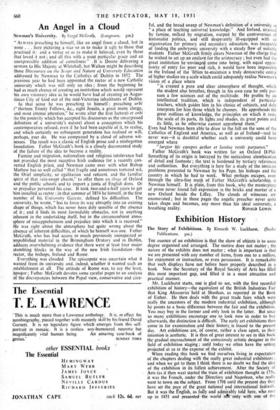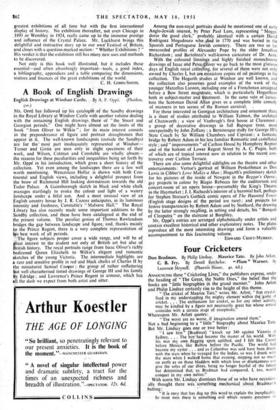Exhibition History •
THE essence of an exhibition is that the show of objects is to some degree organised and arranged. The motive does not matter ; the nature of the exhibits does not matter ; what is important is that we are presented with any number of items, from one to a million, for enjoyment or instruction, or even persuasion. It is remarkable that such displays have not before been properly described in a book Now the Secretary of the Royal Society of Arts has filled this most important gap, and filled it in a most attractive and practical manner.
Mr. Luckhurst starts, one is glad to see, with the first recorded exhibition of history—the equiValent of the British Industries Fair that King Ahasuerus held at Shushan, as reported in the Book of Esther. He then deals with the great trade fairs which were really the ancestors of the modern industrial exhibition, .although he points to a basic difference between the fair and the exhibition. You may buy in the former and only look in the latter. But since so many exhibitions encourage one to look now in order to buy afterwards, the distinction is difficult. The early art exhibitions then come in for examination and their history, is traced to the present day. Art exhibitions are, of course, rather a class apart, as their intention is aesthetic. It is thus of great interest to see in this book the gradual encroachment of the consciously artistic designer in the field of exhibition staging ; until today we often have the setting projected at us at the expense of the exhibit. When reading this book we find ourselves living in expectation of the chapters dealing with the really great industrial exhibitions ; and when we get to them I think there is no doubt we find the idea of the exhibition in its fullest achievement. After the Society of Arts (as it then was) started the train of exhibition thought in 1756, it was the French, under the Directory and Napoleon, who really went to town on the subject. From 1798 until the present day they have set the pace of the great national and international festivals. But it was the English, as fully and admirably told here, who rose up in 1851 and presented the world net only with one of the
greatest exhibitions of all time but with the first international display of history. No exhibition thereafter, not even Chicago in 1893 or Wembley in 1924, really came up to the immense prestige and influence of the Crystal Palace. Mr. Luckhurst brings this delightful and instructive story up to our own' Festival of Britain, and closes with a question-marked section: " Whither Exhibitions ? " His verdict is that the exhibition still has many new uses and methods to be discovered.
Not only is this book well illustrated, but it includes those essential—and often absorbingly important—tools, a good index, a bibliography, appendices and a table comparing the dimensions, visitors and finances of the great exhibitions of the world.
C. H. GIBBS-SMITH.







































 Previous page
Previous page